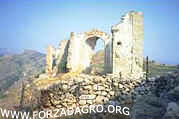The Church of Saint Sebastian |
|
|
This church stands in the ancient Magghia quarter and is dedicated to Saint Sebastian. The saint lived in the 3rd century and was considered protector against the plague, a frequently occurring disaster that over the centuries claimed many victims. The church is small, with one nave, a rectangular plan and a facade that faces south-east. The characteristic local limestone was used for its construction and its four corners are reinforced by large squared blocks of grey sandstone extracted from the overlooking “Vignale” district. These blocks of sandstone form a typical pilaster for the entire height of the building.
Today nothing remains of the roof or of the portal, except for a door post composed of slender blocks of sandstone and crowned by a simple capital. The view from the superior part of the masonry structure suggests that externally there was a sloping pent-roof and a trussed ceiling with exposed beams. At the rear of the nave is an arched structure in sandstone, whitewashed and with simple mouldings in the upper portion. The weight of the masonry above the arch is shared by a double series of trapezoidal sandstone blocks, laid over each other and mutually supporting each other. The apse is a wide masonry curvature at the end of the nave, the upper part concludes with the “basin of the apse”, similar to a semi-cupola. In the lower part, unfortunately partially collapsed, there is a glimpse of a series of arches that embellish the semicircular plan, while in what remains of the upper portion of the basin is a beautiful, if somewhat deteriorated, fresco. This is the Omnipotent, represented with a flowing white beard, a red cloak and the typical triangle on the head. Nothing now remains of the figures of St. Sebastian and of Saint Apollonia, protector of teeth (‘i ianghi in dialect), that were beside him and still remembered by some villagers. Some assert that there was also a figure of St. Barbara. Scrutinising the yellowed background, amongst the cracks that by now form a dense cobweb, can be discerned the delicate design of an angels face. The apse contained the altar of the small church. Next to this, an arched doorway leads to a small room with a shrine and a small window that opens on to the precipice of the deep valley below. A poor and simple church but with a relic of the saint to whom it was dedicated. The period in which it was built is not known but being St. Sebastian, protector against plagues, it is thought that the construction of the religious building came after one of the many epidemics that over the centuries struck the zone. These serious calamities occurred with frequency (1269, 1347, 1355, 1437, 1452, 1468, 1480, 1485, 1500, 1523) and between the 15th and 16th centuries churches dedicated to St. Sebastian were also built in Limina, Mongiuffi Melia, Gallodoro and Gaggi. By now, the small church has been overcome by the challenge of time. Today it is in disrepair and would be difficult to recuperate. The flooring no longer exists and the widespread accumulation of ruins that cover it hide a trapdoor in the middle of the ancient religious building that led to the underground crypt where the bodies of deceased residents of the district were interred. |
|
|
Translation by
Connie Badolato
|
|
|
|
|
|
|
Forzadagro.org 2001-2017 |
|
|


